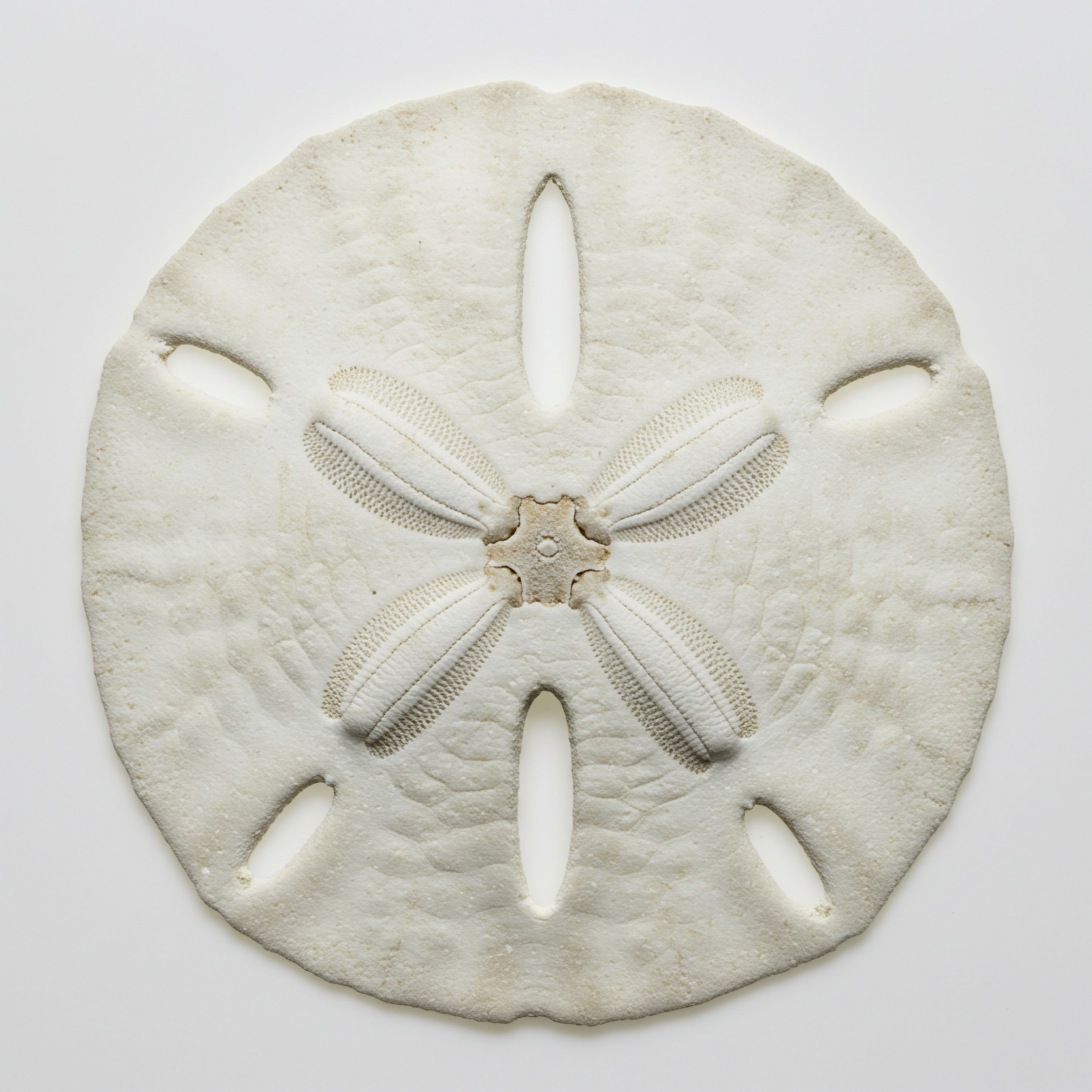

Fundamentals
You have likely noticed changes in your skin over time. A new line that appears by your eyes, a subtle loss of the firmness you once took for granted, or a dryness that no amount of moisturizer seems to fully quench.
These experiences are common, and they are often the first visible signals of a deeper biological shift occurring within your body’s intricate communication network, the endocrine system. The question of whether hormonal optimization protocols can offer longevity benefits for your skin’s appearance is a valid and deeply personal one. The answer is anchored in the science of how hormones, particularly estrogen and testosterone, directly govern the health and structural integrity of your skin.
Your skin is a dynamic, living organ, and its youthful characteristics, such as firmness, elasticity, and hydration, are maintained by a precise biochemical environment. Estrogen, for instance, is a primary architect of this environment. It directly communicates with specialized cells in your skin called fibroblasts, which are responsible for producing collagen and elastin.
Collagen provides the foundational structure and firmness of the skin, while elastin allows it to snap back into place after being stretched. As estrogen levels naturally decline with age, particularly during perimenopause and menopause, this vital communication falters. The result is a measurable decrease in collagen production, leading to thinner, less resilient skin and the formation of wrinkles.
Similarly, estrogen helps the skin retain moisture by increasing the presence of substances like hyaluronic acid, which act like microscopic sponges, holding water within the dermal layers. A reduction in estrogen contributes directly to the increased dryness many women experience.
Testosterone also plays a crucial, albeit different, role in skin health for both men and women. This hormone contributes significantly to skin thickness and its ability to maintain a robust structure. For women, maintaining an optimal, low-dose level of testosterone can support the skin’s foundational integrity, complementing the effects of estrogen.
In men, a decline in testosterone as part of andropause can contribute to changes in skin texture and resilience. Therefore, when we speak of hormonal support for skin longevity, we are referring to a sophisticated recalibration of your body’s internal messaging system. It is about restoring the specific hormonal signals that instruct your skin cells to maintain their youthful function and structure, addressing the biological drivers of visible aging from within.

The Cellular Basis of Hormonal Influence
To understand the connection between hormones and skin, it is helpful to visualize your skin cells as having specific docking stations, or receptors, designed for these hormonal messengers. When a hormone like estrogen circulates through the bloodstream and arrives at the skin, it binds to its specific receptor on a fibroblast cell.
This binding event is like a key turning in a lock, initiating a cascade of instructions inside the cell. The primary instruction given by estrogen is to synthesize new, high-quality collagen. When estrogen is abundant, this process is efficient and continuous, maintaining a dense and well-organized collagen matrix. As estrogen levels wane, fewer receptors are activated, and the signal to produce collagen weakens, leading to the gradual degradation of this vital support structure.
The decline in hormonal signaling directly translates to a decline in the skin’s structural protein production.
This same principle applies to skin hydration. Estrogen signaling helps regulate the production of glycosaminoglycans (GAGs) and hyaluronic acid within the dermis. These molecules are essential for binding water and giving the skin its plump, hydrated quality. Reduced estrogen signaling leads to a diminished capacity to hold moisture, resulting in skin that feels and appears drier. The process is a direct consequence of altered cellular communication, a message that is no longer being sent with the same frequency or intensity.

How Do Hormones Affect Skin Appearance in Men and Women?
While the fundamental mechanisms are similar, the specific hormonal influences on skin can manifest differently between men and women, reflecting their distinct endocrine environments. For women, the sharp decline in estrogen during menopause often precipitates a more sudden and noticeable acceleration of skin aging.
Many women report a rapid onset of fine lines, sagging, and dryness in the months and years following their last menstrual period. This experience is a direct reflection of the loss of estrogen’s protective and regenerative signals. Consequently, estrogen therapy in postmenopausal women has been shown in clinical studies to increase skin thickness, improve elasticity, and boost collagen content, effectively counteracting these changes.
For men, the age-related decline in testosterone, or andropause, is typically more gradual. The effects on the skin may be less abrupt but are still significant. Testosterone contributes to the overall thickness and sebum production of the skin, which is why men’s skin is, on average, thicker and more sebaceous than women’s.
As testosterone levels decrease, men may notice their skin becoming drier and less robust over time. Testosterone replacement therapy (TRT) in men with clinically low levels can help maintain the skin’s structural integrity and support its overall health.
In women, low-dose testosterone therapy is also utilized for its systemic benefits, which extend to the skin. By supporting the foundational thickness and resilience of the dermis, it works in concert with estrogen to create a more comprehensive support system for skin health. This dual approach acknowledges the synergistic roles these hormones play in maintaining the skin’s complex biological architecture.


Intermediate
Understanding that hormonal decline impacts skin is the first step. The next is to appreciate the clinical strategies designed to address this decline. Hormonal optimization protocols are not a one-size-fits-all solution; they are highly personalized interventions tailored to an individual’s specific biochemistry, symptoms, and health goals.
The objective is to restore the body’s signaling pathways to a more youthful and functional state, and this requires a nuanced approach that considers the interplay of various hormones. For skin longevity, the focus is primarily on recalibrating the levels of key hormones like estrogen, progesterone, and testosterone to re-engage the cellular machinery responsible for skin health.
Clinical protocols for women often involve a combination of hormones to replicate a balanced premenopausal state. For instance, a typical regimen for a postmenopausal woman might include estradiol, the most potent form of estrogen, to directly stimulate collagen and hyaluronic acid production.
This is often paired with progesterone, which helps to balance the effects of estrogen and may also contribute to skin hydration. In many cases, a low dose of testosterone cypionate is also included. This addition is critical because testosterone supports the skin’s structural thickness and integrity, providing a benefit that estrogen alone does not fully address.
The use of Anastrozole, an aromatase inhibitor, may be considered in specific cases to manage the conversion of testosterone to estrogen, ensuring the desired balance is maintained.
For men undergoing Testosterone Replacement Therapy (TRT) for andropause, the protocol typically involves weekly intramuscular injections of Testosterone Cypionate. This therapy directly addresses the declining testosterone levels that can affect skin integrity. To support the body’s own hormonal axis, Gonadorelin is often prescribed.
Gonadorelin mimics the action of Gonadotropin-Releasing Hormone (GnRH), stimulating the pituitary gland to produce Luteinizing Hormone (LH) and Follicle-Stimulating Hormone (FSH), which in turn encourages the testes to produce testosterone and maintain their function. This integrated approach ensures that the therapy supports the entire endocrine system, not just a single hormone level.

Protocols for Female Hormonal Support
The approach to hormonal support for women is highly dependent on their menopausal status and individual needs. The goal is to alleviate symptoms and provide long-term protective benefits, including for the skin. The following table outlines typical starting protocols, which are always adjusted based on lab results and patient response.
| Hormone/Medication | Typical Protocol | Primary Role in Skin Health |
|---|---|---|
| Testosterone Cypionate | 10 ∞ 20 units (0.1 ∞ 0.2ml) weekly, subcutaneous | Supports dermal thickness and structural integrity. |
| Estradiol | Delivered via cream, patch, or pellet | Stimulates collagen and elastin synthesis, increases hydration. |
| Progesterone | Oral capsules or topical cream, dosed based on cycle | Balances estrogen and may support skin hydration. |
| Anastrozole | Used selectively to manage estrogen levels | Prevents excess conversion of testosterone to estrogen. |
A balanced hormonal environment is achieved through the careful titration of multiple synergistic hormones.
For pre-menopausal and peri-menopausal women, the focus may be on regulating cycles and addressing initial symptoms of hormonal fluctuation. In this context, progesterone may be used cyclically to stabilize the menstrual cycle, while low-dose testosterone can address symptoms like low energy and also provide foundational support for skin health.
For post-menopausal women, a more comprehensive regimen involving estrogen, progesterone, and testosterone is common, aimed at restoring a more youthful hormonal milieu and directly targeting the mechanisms of skin aging.

Protocols for Male Hormonal Support
For men experiencing the symptoms of andropause, including changes in skin, Testosterone Replacement Therapy (TRT) is the primary intervention. The protocol is designed not only to restore testosterone levels but also to maintain the body’s natural hormonal feedback loops.
- Testosterone Cypionate ∞ This is the foundational element of male TRT, typically administered as a weekly intramuscular injection. It provides a steady, reliable source of testosterone to restore systemic levels, thereby supporting muscle mass, energy levels, and skin integrity.
- Gonadorelin ∞ Administered subcutaneously twice a week, Gonadorelin is crucial for preventing testicular atrophy, a common side effect of TRT. By stimulating the HPG axis, it helps maintain natural testosterone production and fertility.
- Anastrozole ∞ This oral medication is an aromatase inhibitor, used to control the conversion of testosterone into estrogen. While some estrogen is necessary for male health, excessive levels can lead to side effects. Anastrozole helps maintain an optimal testosterone-to-estrogen ratio.
- Enclomiphene ∞ This may be included in some protocols to further support the production of LH and FSH, offering another layer of support for the body’s natural endocrine function.
This multi-faceted approach ensures that the benefits of testosterone are realized while mitigating potential side effects and supporting the overall health of the endocrine system. The resulting hormonal balance contributes to the maintenance of healthier, more resilient skin.


Academic
A sophisticated examination of the longevity benefits of hormonal therapies on skin appearance requires a deep dive into the molecular biology of skin aging and the specific pharmacodynamics of exogenous hormones. The visible deterioration of skin quality with age is a clinical manifestation of complex, interconnected processes at the cellular and tissue levels, governed significantly by the Hypothalamic-Pituitary-Gonadal (HPG) axis.
The decline in gonadal steroid output ∞ estradiol in women and testosterone in men ∞ initiates a cascade of downstream effects in peripheral tissues, with the skin being a primary and highly visible target.
Estrogen’s role in maintaining skin’s youthful physiology is mediated through its binding to two specific nuclear receptors found in the skin ∞ Estrogen Receptor Alpha (ERα) and Estrogen Receptor Beta (ERβ). These receptors are present in keratinocytes, fibroblasts, melanocytes, and hair follicles.
Upon binding with estradiol, these receptors form a complex that translocates to the cell nucleus and binds to specific DNA sequences known as Estrogen Response Elements (EREs). This action modulates the transcription of target genes, including those responsible for the synthesis of Type I and Type III collagen, elastin, and various glycosaminoglycans (GAGs).
Clinical studies have quantitatively demonstrated this effect; research has shown that oral estrogen therapy can increase dermal thickness by up to 30% and significantly increase skin collagen content in postmenopausal women. The mechanism is direct ∞ restoring circulating estrogen levels reactivates the genomic pathways that drive the production of the skin’s structural matrix.
Furthermore, estrogen enhances the skin’s barrier function and hydration. It achieves this by increasing the synthesis of hyaluronic acid and other mucopolysaccharides in the dermis, which are critical for water retention. Evidence also suggests that estrogen improves the integrity of the stratum corneum, the outermost layer of the epidermis, reducing transepidermal water loss (TEWL).
The observed increase in skin elasticity and reduction in wrinkle depth in women on HRT is a direct result of these combined effects ∞ a thicker, more collagen-rich dermis coupled with improved hydration.

The Synergistic Role of Androgens in Dermal Integrity
While estrogen is paramount for female skin health, androgens, particularly testosterone, play a vital and often underestimated synergistic role. Testosterone’s influence on the skin is mediated through androgen receptors (AR), which are also present in fibroblasts and sebaceous glands. In both men and women, testosterone is a key regulator of skin thickness. It stimulates dermal collagen production, contributing to the skin’s structural robustness. This is why men, who have significantly higher endogenous testosterone levels, generally have thicker skin than women.
In female hormonal therapy, the inclusion of low-dose testosterone addresses a component of skin health that estrogen alone does not fully optimize. While estrogen excels at promoting collagen and hydration, testosterone provides a foundational strengthening of the dermal structure. One study highlighted a 48% increase in skin collagen content in women treated with a combination of estradiol and testosterone.
This suggests a potentially synergistic or additive effect when both hormones are present at optimal levels. The clinical protocol of combining Testosterone Cypionate with estradiol for women is therefore grounded in this understanding of dual-hormone influence on the dermal matrix. For men on TRT, the therapy directly counteracts the age-related decline in testosterone, helping to preserve the skin’s thickness and collagen content that would otherwise diminish with andropause.

What Is the Impact of Aromatase Inhibition on Skin Health?
The use of aromatase inhibitors like Anastrozole within hormonal optimization protocols introduces another layer of complexity. Aromatase is the enzyme responsible for converting androgens (like testosterone) into estrogens. In both male and female protocols, Anastrozole is used to modulate this conversion, thereby controlling estrogen levels and maintaining a desired hormonal ratio.
In men on TRT, this prevents potential side effects from excessive estrogen, such as gynecomastia. In women on testosterone therapy, it can prevent the supraphysiological conversion of supplemental testosterone into estrogen.
From a dermatological perspective, this modulation has direct implications. By controlling estrogen levels, Anastrozole ensures that the effects of testosterone on skin thickness can be realized without being overshadowed by excessive estrogenic effects. The goal of a well-designed protocol is to achieve a hormonal balance that is optimal for systemic health and provides the desired benefits for target tissues like the skin.
The precise management of the testosterone-to-estrogen ratio is a key aspect of advanced hormonal therapy, allowing for the fine-tuning of clinical outcomes, including those related to skin appearance and longevity.
The following table details the specific cellular impacts of key hormones used in optimization protocols.
| Hormone | Receptor Target | Primary Cellular Action in Skin | Observed Clinical Outcome |
|---|---|---|---|
| Estradiol | ERα, ERβ | Increases transcription of collagen I & III, elastin, and hyaluronic acid genes. | Increased skin thickness, elasticity, and hydration; reduced wrinkles. |
| Testosterone | AR | Stimulates dermal fibroblast proliferation and collagen synthesis. | Increased skin thickness and structural integrity. |
| Progesterone | PR | Modulates sebaceous gland activity and may inhibit collagen breakdown. | Supports skin hydration and balances estrogenic effects. |

References
- Stevenson, S. & Thornton, J. (2007). Effect of estrogens on skin aging and the potential role of SERMs. Clinical Interventions in Aging, 2(3), 283 ∞ 297.
- Calleja-Agius, J. & Brincat, M. (2015). Menopause and the effects of Hormone Replacement Therapy on skin aging ∞ A Short Review. Gynecological and Reproductive Endocrinology & Metabolism, 1(1), 1-5.
- Shah, M. G. & Maibach, H. I. (2001). Estrogen and skin. An overview. American Journal of Clinical Dermatology, 2(3), 143 ∞ 150.
- Lephart, E. D. (2022). Updated Perspectives on the Role of Estrogens in Skin Aging. Clinical, Cosmetic and Investigational Dermatology, 15, 1639 ∞ 1655.
- Biopelle. (n.d.). The Relationship Between Collagen and Estrogen. Retrieved from Biopelle website.
- Hall, G. & Phillips, T. J. (2005). Estrogen and skin ∞ the effects of estrogen, menopause, and hormone replacement therapy on the skin. Journal of the American Academy of Dermatology, 53(4), 555-568.
- Raine-Fenning, N. J. Brincat, M. P. & Muscat-Baron, Y. (2003). Skin aging and menopause ∞ implications for treatment. American Journal of Clinical Dermatology, 4(6), 371-378.
- Verdier-Sévrain, S. & Bonté, F. (2007). Skin hydration ∞ a review on its molecular mechanisms. Journal of Cosmetic Dermatology, 6(2), 75-82.

Reflection
The information presented here provides a map of the biological pathways that connect your internal hormonal environment to the visible health of your skin. You have seen how specific hormonal signals orchestrate the very structure and vitality of this essential organ. This knowledge is the foundation.
It shifts the conversation from merely treating the surface to understanding and addressing the systemic drivers of change. Your own health story is unique, written in the language of your body’s specific biochemistry. The path forward involves translating this general scientific understanding into a personalized strategy.
Consider what you have learned not as a final answer, but as a set of well-defined questions to bring to a conversation about your own long-term wellness. The potential for sustained vitality is immense when you begin to work in concert with your body’s own intricate systems.

Glossary

hormonal optimization protocols

structural integrity

fibroblasts

estrogen

estrogen levels

perimenopause

hyaluronic acid

skin thickness

testosterone

hormonal support

andropause

skin hydration

skin aging

testosterone replacement therapy

testosterone levels

skin health

hormonal optimization

that estrogen alone does

testosterone cypionate

anastrozole

gonadorelin

endocrine system

increase skin collagen content

dermal thickness




